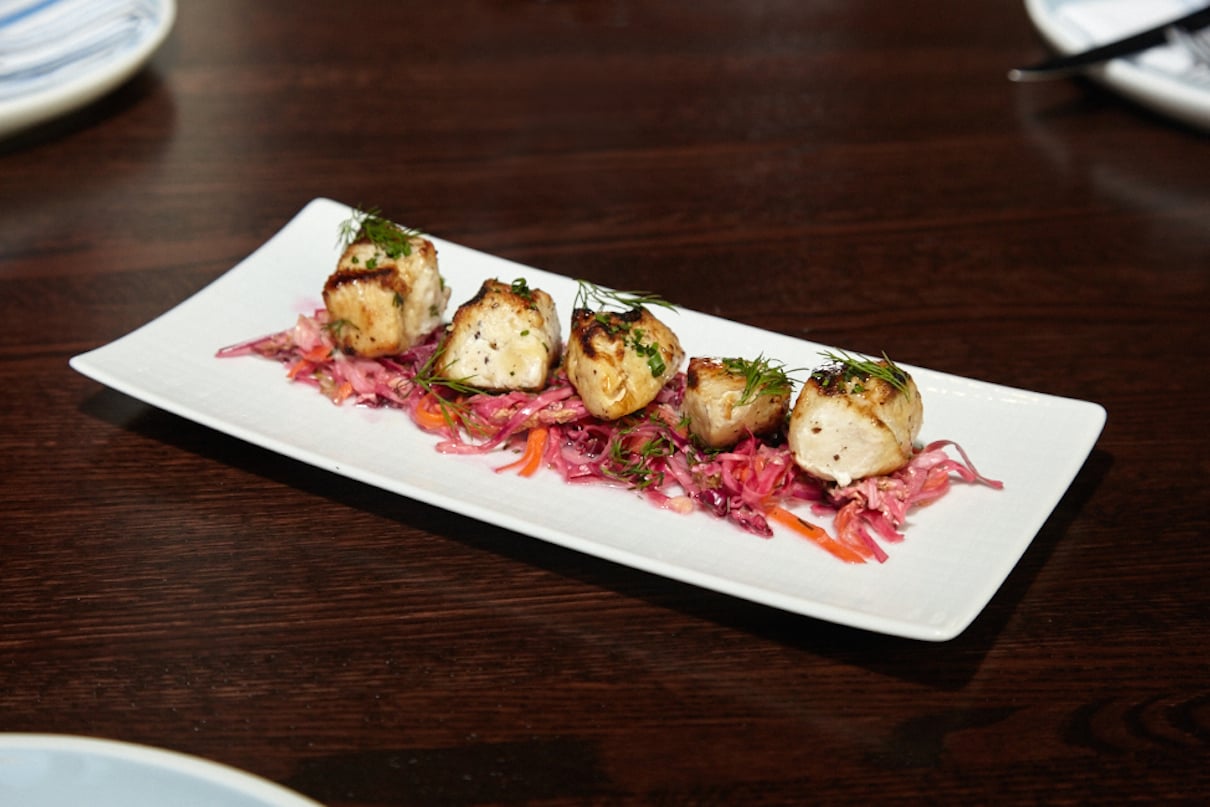This past spring, Wolfgang Puck held forth at a glitzy, balloon-festooned press conference that was staged in DC to announce that he opening a new restaurant. Next year.
That news was followed by rumors that Eric Ripert, the French chef of New York’s four-star Le Bernardin, would be taking over the kitchen of the Ritz-Carlton in DC’s West End.
Next year.
The anticlimax of these announcements did not stop gastronomes from pronouncing the arrival of Puck and Ripert as proof that Washington is a big-time restaurant city. Never mind that neither of the celebrity chefs is likely to make more than a token appearance here, let alone do any cooking.
Meanwhile, in September, a genial, bespectacled cook named Barry Koslow left Circle Bistro, where he was second in command, to take over the top spot at Mendocino Grille and Wine Bar in Georgetown. There was no press release and nary a balloon.
Koslow lacks wattage, but he does not lack talent. An Alexandria native who has served a long apprenticeship under Michel Richard, Todd Gray, Jonathan Krinn, and Brendan Cox, Koslow is what you might call a cook’s cook. His dishes are sturdy, free of flash, and blind to almost all trends. Amid the wine-stoked atmosphere of a weekend night, it’s easy to lose sight of just how good and well constructed his plates are.
An appetizer of ravioli filled with butternut squash and robiola cheese, flecked with torn sage, and topped with crushed amaretti made me and my wife take notice.
“How often do you see cookies crumbled atop a starter?” she asked, raising her voice above the cocktail-party din of the cozy, 45-seat space.
“And how often,” I replied, “does it actually work?”
But it was a dish of striped sea bass, pooled in a briny, fragrant broth of mussel juice and saffron and graced by tiny coins of fiery chorizo and braised fennel that made me want to taste everything on the menu.
A lot of chefs disdain fish, finding it a poor cousin to meat, which affords greater opportunities for extracting and intensifying flavors. As a result, too often they force a fish into playing the role of meat—or, alternatively, go the minimalist route by surrounding a piece of fish with a wan ensemble of vegetable and starch.
Koslow does neither. His treatment of black sea bass is that rare plate of fish in which all the components of the dish are harmonized, and you realize delicacy and lusciousness aren’t mutually exclusive.
A filet of yellowtail with long beans, slices of taro root, and a cap of grated ginger might not reach those heights, but the accoutrements are so smartly handled, so well harmonized, that you never feel as though the French-trained Koslow is dabbling in Orientalism.
Halibut is among the more difficult fish to work with, the virtues of its white, meaty flakiness offset by its lack of flavor. It’s a measure of Koslow’s skill that he almost succeeds in reviving this overemployed fish, despite cooking it just past the point of soft lusciousness on the night I ordered it. The plate was awash in painterly color, a garland of juicy orange segments, sweet roasted beets, and braised kohlrabi encircling a plump square of roasted fish.
Koslow even knows when to break his own rules. Tuna carpaccio is the kind of item you have on a menu to please the beautiful young things who gather at the bar to sip and graze. But the quality of tuna has declined so much that in all but the most expensive restaurants it’s hardly worth ordering—beautiful to look at, mealy to eat. Koslow transforms what used to be a showpiece appetizer for many chefs into a seaweed salad, the thin, yuzu-slicked bands of tuna there mostly to provide a textural change of pace.
The rest of the menu—six appetizers, seven entrées—finds Koslow sublimating the restaurant’s commitment to California cooking to his brand of French classicism. So far the transition has been almost as seamless as the sound system’s nightly segues from Ray Charles to Miles Davis to Johnny Cash to Astrud Gilberto.
One of the benefits of this marriage of convenience is that hearty, rich dishes like the rabbit pâté are smartly reconfigured for everyday eating. I ordered this appetizer twice in the course of three visits, rationalizing my desire for another taste as a crucial test of consistency. It’s a hefty portion—a thick, bacon-wrapped wedge—and the wonder is that so strong and assertive a taste should be so soft, almost mousselike in its consistency. It goes down even more easily thanks to a small pile of pickled mushrooms and a pungent dab of violet-colored mustard.
I love the studly venison chop, its juniper-berry sauce accentuating the deep, liverish flavors of the meat. And a breast of duck resuscitates my interest in a dish that has become perfunctory on many menus; the meat is rosy and full of savor, the skin salty and crispy.
In too many kitchens, vegetables and fruits are relegated to duty as hearty “sides.” Koslow integrates them into his compositions and exploits their potential. The venison is embroidered with perfectly cooked baby carrots and a luscious, roasted pear half. The bittersweetness of glazed turnips is a fitting foil for the fattiness of the duck.
Sometimes Koslow overreaches. A parsnip-and-apple soup marred by the inclusion of a handful of smoked oysters is an odd, intriguing failure.
Sometimes he underreaches. A grilled Caesar salad is a tired idea, and you sense his lack of investment in it; a salad of black cod, on the other hand, is an interesting idea but not entirely thought through: The cod is so strong, so oily, it obliterates the lettuce on the plate.
Missteps are few. Mostly, I have quibbles. The crispy sweetbreads would get my ringing endorsement but for a too-sweet orange-honey glaze that nudges the diner too hard to call to mind a honey dipping sauce—much as the sweetbreads themselves, served on mini skillets, are meant to impersonate Southern fried chicken. I liked, but didn’t love, the pan-seared gnocchi topped with baby arugula and grana padano, but the cork-size nubbins were too big and rusticky for such a delicate preparation.
Joining an established restaurant has been a boon for the young chef, surrounding him with a capable staff that understands how to be unobtrusive without appearing distant and enabling him to keep his menu small and focused. But the fit is not perfect. The restaurant’s wine program, formerly a strength—allowing diners to choose from more than 30 wines by the glass and even half pours—works against him: The more refined flavors of Koslow’s plates call for less ripe, fleshy wines than the California-dominated list now delivers. Likewise, more French cheeses on the list would be welcome.
More reinvention is in order, some give and take. I’d like to see the Cali-themed restaurant cede more ground to the chef’s Frenchified style. But that’s for later. For now, the emergence of this cook’s cook is as important as the news that Puck and Ripert will soon gift the city their names—and potentially more rewarding.
Mendocino Grille
2917 M St., NW; 202-333-2912; open daily for dinner.
Neighborhood: Georgetown.
Dress: Casual.
Noise: Boisterous around the bar up front, a civilized din in the dining room.
Best Dishes: Rabbit pâté; ravioli with butternut squash and robiolo; roasted striped sea bass with chorizo and fennel; yellowtail with long beans and taro root; venison chop; duck breast with duck confit and cabbage; chocolate pot de crème
Price range: Starters $9 to $14, entrées $19 to $31.

















